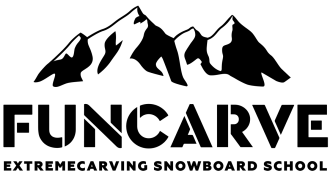Extremecarving. «Push-n-pull» technique
Technique ‘Push-n-Pull’ is a modification of down unweighting in its timing. Its distinctive feature is smooth bending of the knees which doesn’t provide unweighting of the board for change of the edge. That’s why a lot of attention is paid to rotation in carving.
The task of Push-n-Pull
..is to create the conditions for the deepest inclination in the beginning of the turn, which is necessary for laid-down turn.
The main advantages of down unwighting are exactly the major reason for being chosen by extremecarvers for their style. However in its academic performance it cannot help to make a laid-down turn. To make a laid-down turn you need to give up all harsh movements because edging angles are 75-85° and they can be broken easily on high speeds. Also to make a laid-down turn you need to be straightened up by the middle of the turn and after it you should smoothly approach the edge change.
Shifting timing of movements closer to the centre of the turn leads to the situation when board doesn’t unweight in process of edge changing because vertical motion is too slow. That’s exactly why you have to recall Rotation and to use it to change the edge. Combination of Rotation and Push-n-Pull creates all the conditions for successful laid-down turn and for finishing it with good speed.
Key aspects
- You should choose the speed of knees unbending in the beginning of the turn relatively to the moment when you plan to reach the centre of the carve;
- You should incline into the turn already in the beginning of the turn when your knees are bent;
- In the middle of the carve when crossing the fall line your knees are unbent but not so much to lock the knee joint;
- After the fall line you should bend your knees smoothly and finish inclination by taking your hips away first from the slope.
- Compare this timing with one of down unweighting. Pay attention to the smoothness of knees bending in Push-n-Pull technique which leads to the necessity of using Rotation to change the edge.
Turn
As soon as you have changed the edge you should straighten your legs and incline into the turn proportionally. Your maximum inclination and the most unbent knees should be in the centre of the cave, on the fall line. You shouldn’t stay in such position for a long time because your board is prone to micro-disruption from its edge without damping of the imperfections of the slope.
Right after crossing the fall line you should start bending your knees but do it in the same pace as you were unbending them – slowly and proportionally to the turn and the speed. Also after crossing the fall line you should exit your deep inclination because delay can result in too much friction in the end of the carve and loss of speed and contact.
Edge change
After crossing the fall line you should also come to ‘Minus’ or ‘Plus’ position depending on the turn to create extra motion for the rotation. By the moment of rotation your knees should be strongly bent in order you can be in deep inclination right after the edge change. After that you return to basic position and change the edge. When you feel the support with your heels/toes you should push your knees.
- The smoother you unbend your knees and the faster you bend them the lesser losses of speed will be;
- You can control your speed by increasing or reducing the phase of high friction;
- The combination of down-unweighting with rotation allows achieving extremely deep inclination in turn what is called Extremecarving;
- Push-n-Pull technique is the modification of down-unweighting and it was renamed for better understanding of the movements used in it.
Typical mistakes
- Rather shallow inclinations.
Push-n-Pull is initially designed for deep inclinations and laid-down turns and if due to some reason you are not ready to be so close to the slope then it is better to return to practicing inclinations. For some time :) - Shallow or implicit vertical motion.
Push-n-pull demands extremely good sense of balance because you have to spend about 80% of the snowboarding time with your knees bent. If you find it difficult to overcome the reflexes and to bend your knees smoothly under exertion then you will not be able to match the timing. Practice your down unweighting with your shoes undone, when drifting and on low speeds. You will inevitably reach balance and timing and having achieved this you will be able to make a step forward.
- Too early unbending of the knees.
If you unbend your knees earlier than you make a deep inclination then on the contrary you will push yourself from the slope. Wait until your inclination becomes sufficient for unbending the knees ‘inside’ the turn instead of up from slope. - Static position of the shoulders or the wrong timing of the rotation.
Rotation plays the main role in Push-n-Pull. Because of the smoothness of knees bending the board doesn’t unweight and it doesn’t change the edge. This role is played by rotation. However to make rotation with your knees bent you should learn it perfectly. Don’t hesitate to do a few first runs using only rotation. - Your back hand rests on the slope.
Deep inclinations always lead to a kind of imbalance and a person isn’t used to be in such a state. That’s why people seek for some support. Restrain yourself from stretching your back arm and resting it on the slope. This will lead to the loss in speed and break of the carve and possible fall. Try to stretch your leading arm to the slope! :)



